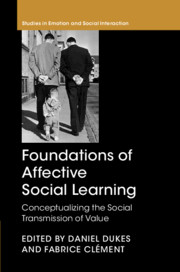Book contents
- Foundations of Affective Social Learning
- Studies in Emotion and Social Interaction
- Foundations of Affective Social Learning
- Copyright page
- Dedication
- Contents
- Figures
- Contributors
- Preface
- A difficult introduction to affective social learning
- Part I On the evolutionary foundations of affective social learning processes
- Part II On human development and affective social learning
- Chapter 3 Affective social learning
- Chapter 4 Natural pedagogy of social emotions
- Part III On the mechanics of affective social learning
- Part IV Applications of affective social learning
- Conclusion
- Index
- Studies in Emotion and Social Interation
- References
Chapter 3 - Affective social learning
From nature to culture
from Part II - On human development and affective social learning
Published online by Cambridge University Press: 09 August 2019
- Foundations of Affective Social Learning
- Studies in Emotion and Social Interaction
- Foundations of Affective Social Learning
- Copyright page
- Dedication
- Contents
- Figures
- Contributors
- Preface
- A difficult introduction to affective social learning
- Part I On the evolutionary foundations of affective social learning processes
- Part II On human development and affective social learning
- Chapter 3 Affective social learning
- Chapter 4 Natural pedagogy of social emotions
- Part III On the mechanics of affective social learning
- Part IV Applications of affective social learning
- Conclusion
- Index
- Studies in Emotion and Social Interation
- References
Summary
Recent research has shown that children often learn what to believe by attending to the claims of other people. Similarly, they often learn how to act by attending to the actions of other people. Moreover, in each of these two domains, children are selective in their learning – they prefer to endorse and to emulate individuals who, as representatives of the surrounding culture, can serve as good models. I argue that this type of selective social learning also plays a major role in children’s emotional development. Although young children may encounter some situations that have a universal biological significance – for example a steep cliff or a sudden loud noise – the emotional implications of many encounters, especially with artefacts, people and foods, are likely to vary from one culture to another. Children can learn to perceive these encounters through the distinctive emotional lens of their own culture if they attend to and adopt the expressive appraisals of individuals who are representative of their culture. Such appraisals may be conveyed non-verbally, as in the classic social-referencing paradigm, but they can also be conveyed verbally.
Keywords
- Type
- Chapter
- Information
- Foundations of Affective Social LearningConceptualizing the Social Transmission of Value, pp. 69 - 86Publisher: Cambridge University PressPrint publication year: 2019



